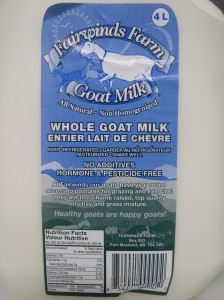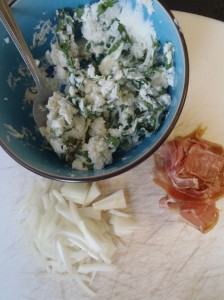I recently looked up “mozzarella” in Larousse, and found the following descriptions:
- “a fresh cheese, springy and white”
- “kept in salted water or whey, shaped into balls or loaves of varying size”
This sounded utterly unlike any mozzarella I’ve had before. Turns out there are two types of mozzarella in this world: the traditional fresh mozzarella, described above, and the American low-moisture mozzarella, which includes the familiar white bricks at the grocery store. Traditional mozzarella belongs to a class of cheeses called pasta filata, which means “spun paste” or “spun curds”. The curds are heated, then stretched repeatedly to develop an elastic texture in the finished cheese. Other cheeses made by this method are provolone, scamorza, and caciocavallo.
I … Continue reading.
 My ideal yogurt is Greek yogurt, which is thick, rich, flavourful, and made of sheep’s milk. Unable to find whole sheep’s milk, I’m experimenting with goat’s milk from Fairwinds Farm of Fort Macleod, Alberta, as it is fattier (and just more Greek) than cow’s milk.
My ideal yogurt is Greek yogurt, which is thick, rich, flavourful, and made of sheep’s milk. Unable to find whole sheep’s milk, I’m experimenting with goat’s milk from Fairwinds Farm of Fort Macleod, Alberta, as it is fattier (and just more Greek) than cow’s milk.
There are two ways to culture yogurt at home. The first is to add a small amount of commercial yogurt containing active cultures to milk. The second is to use pure bacterial cultures. Regardless of which method you use, the process is basically the same.
Danlac Starter Kit
I eventually want to make cheese with pure bacterial cultures. I contacted Danlac in Airdrie, and ordered a starter kit containing several doses of rennet and cultures … Continue reading.
Today was devoted to playing with the simple formula (dairy) + (heat) + (acid) = (fresh cheese), that is, changing the dairy, acid, and amount of heat to manipulate the taste and texture of the finished cheese.
Mascarpone
 Mascarpone, the most mispronounced of all Italian cheeses, is made from whole cream, and is usually curdled with lemon juice or straight citric acid. My recipe from the Culinary Institute of America’s Garde Manger, Third Edition,called for tartaric acid (available at brewing supply stores), the taste of which took a distant backseat to the rich, buttery flavour of the cream.
Mascarpone, the most mispronounced of all Italian cheeses, is made from whole cream, and is usually curdled with lemon juice or straight citric acid. My recipe from the Culinary Institute of America’s Garde Manger, Third Edition,called for tartaric acid (available at brewing supply stores), the taste of which took a distant backseat to the rich, buttery flavour of the cream.
- 1.92L heavy cream
- 1/2 tsp tartaric acid
Here are some brusque instructions. Heat cream to 80°C. Stir to prevent burning. Remove … Continue reading.
I’m starting my foray into cheese-making with a few simple, fresh cheeses. First I’d like to cover the basics.
Cheese: A Blunt Introduction

Cheese is curdled dairy. “Curdling” is the coagulation of proteins. In cheese-making, heat, acid, and certain enzymes are used to coagulate the major protein in dairy, casein. Subjecting dairy to heat and acid or enzymes (or both) will separate the mixture into solid curds and liquid whey. The curds contain most of the protein, fat, and nutrients of the original dairy product. From an anthropological perspective, the principle benefit of cheese-making is that most of the energy and nutrients of the milk are solidified into a longer-lasting, easily-transported mass (that happens to taste amazing).
The whey, while … Continue reading.
The personal website of Edmonton chef Allan Suddaby


